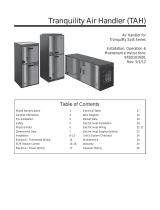Overview
The N-TAH permits devices which use contact closure signals to communicate with each
other to be connected over an Ethernet network. The N-TAH acts as a virtual cable
connection, permitting signals to be sent between units as if there was a direct
connection between them. This allows the distance between customer equipment to be
greatly increased, and reduces the number of cables needed to connect multiple pieces
of customer equipment.
The N-TAH makes contact inputs and outputs accessible on a network. Other devices
on the network (including other AFI devices such as the N-111 or Commander) can
connect to these ports, or accept connections from them, allowing contact closure
events to be transmitted between devices. The N-TAH comes with a configuration web
interface which can be used to link contact ports on multiple N-TAH devices together to
provide a transparent connection between customer equipment over the network.
In addition to providing transparent contact connections between customer equipment,
the N-TAH is also intended to work as part of a system with V’NES Pilot software. This
permits features such as logging of contact events or environmental sensor data.
Alarm input forwarding
The N-TAH has two contact inputs which can be connected to customer supplied contact
closure devices such as motion detectors or door switches. Each alarm input can be
linked through the N-TAH to trigger an aux contact output on that device, or another N-
TAH device or other AFI devices elsewhere on the network.
The conditions which will be considered an alarm can be set through the configuration
web page. Thus the N-TAH can be used with alarms where a contact is broken (such as
a wire break or emergency stop switch) or where a contact is made (such as a motion
detector). The minimum duration that the contact must be made or broken before an
alarm is registered can also be set by the user, so that the user can set an alarm to
trigger only if an alarm condition has been present for a certain amount of time.
Each aux input may also be configured to operate in ‘supervised’ mode, where the
contact will only be triggered when a 1K resistance is detected across the input. Either
an open circuit or a short circuit will be detected as no contact made. This can be set by
the user through the configuration screen.
When an alarm is triggered, the N-TAH can be set to activate aux output contacts either
on that same N-TAH, or on other N-TAH or AFI devices on the network. The user can
set which output to set and whether to turn it on or off in response to the triggered alarm.
The user can also set the target aux contact out to be set on or off for a specific duration
in response to a local alarm condition. Alternately the user can set the target aux
contact out to be set on or off indefinitely in response to a local contact, so that a local
contact will cause an aux out to be set or cleared until some other trigger clears or sets
that aux output.
The permitted targets of aux contact actions to be taken in response to local alarms are
any N-TAH devices, or any other compatible AFI devices such as the N-111 or C10























